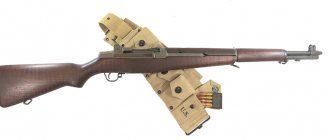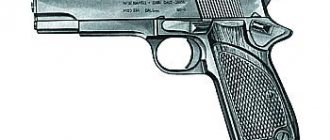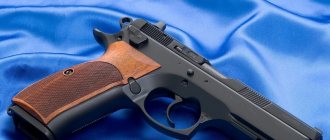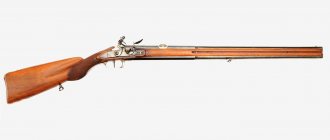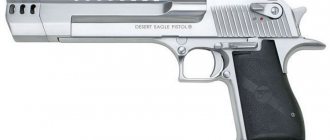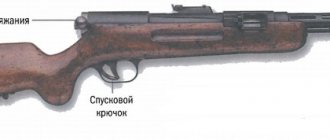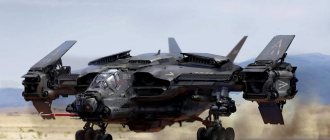Domestic small arms [Wings of Russia studio] (2011)
Year of release:
2011
Director:
Konstantin Davydkin, Viktor Korablin
Text read by:
Andrey Yaroslavtsev, Elena Solovyova
Description:
Documentary series about domestic small arms.
Film 1: SMALL ARMS OF WORLD WORLD FIRST
The First World War served as an impetus for the development of small arms in many armies around the world. Machine guns began to be actively used on the battlefields. They were used in infantry and installed on aircraft, tanks and armored vehicles. Submachine guns, automatic rifles, and light machine guns appeared in the infantry's arsenal. The main weapons of the Russian army during the First World War were: a three-line Mosin rifle, a Maxim system machine gun and a Nagant revolver. This legendary weapon faithfully served soldiers until the end of the Great Patriotic War.
Movie 2: RIFLES AND SMGs
The famous “three-line” was adopted by the Russian army in 1891. During the First World War, they began to think about replacing it with more advanced, automatic weapons. One of the first to work on the creation of domestic automatic weapons was Vladimir Fedorov. In 1916, he created the first Russian machine gun, but this weapon never became widespread. Work on new types of small arms continued under Soviet rule. In the mid-twenties, the development of automatic rifles and submachine guns began in the USSR. They will be discussed in this series.
Film 3: MACHINE GUNS. PART 1
The Maxim system machine gun, created in 1883, was the ancestor of all machine guns. This is where the history of this type of weapon in the Soviet Union began. By the beginning of the 21st century, the role of machine guns had increased significantly. From auxiliary they turned into the main weapon of the infantry. This series tells about the history of domestic machine guns - from the legendary "Maxim" to "Pecheneg" - one of the best machine guns in the world.
Film 4: MACHINE GUNS. PART 2
Heavy machine guns are the most powerful small arms. Their story began during the First World War. At the same time, machine guns began to be used in aviation. These two separate types of machine guns - large-caliber and aircraft - will be discussed in this series.
Movie 5: MACHINES
At the end of the 50s of the 20th century, rifles and submachine guns were replaced by the Kalashnikov assault rifle. It gained wide popularity and became the most popular small arms in the world. This series is a story about how the Kalashnikov assault rifle was created and improved, and about how domestic assault rifles have changed over the past fifty years. Quality: SATRip
Movie 6: SILENT AND SPECIAL WEAPONS
Silent and special weapons are a special type of small arms. A shooting knife, a silent pistol, a submachine gun for underwater shooting - these are all weapons of special forces.
The history of domestic silent weapons began in the 30s of the last century. But the most active development of special weapons occurred during the Cold War. The scandal with the downed American pilot Gary Powers played a role in this.
Movie 7: SNIPER WEAPON
For sniper shooting, only a high-quality rifle with an optical sight is not enough. Only a combination of a well-trained shooter, special combat equipment and the right tactics can ensure the effective use of sniper weapons in combat.
This series tells about the history of the creation and use of domestic sniper weapons - from the Mosin rifle to modern Russian models.
Film 8: PISTOLS
“Tula Tokarev”, Makarov pistol and Stechkin automatic pistol - these weapons have become widely known throughout the world. But many pistols created in the Soviet Union did not receive such fame, although no less interesting. In this series we will talk about the history and modernity of domestic army pistols.
Small arms of the Russian army (Russia, 2019) - View all episodes
In 1891, the 3-line rifle of the Mosin system, the famous “three-line”, was adopted by the Russian army. Before the beginning of the 20th century, they managed to add the Nagan revolver and the Maxim machine gun to it. These three samples constituted the first domestic small arms system using smokeless powder. Over the next hundred years, the small arms system of the Russian Army, the Red Army and the Soviet Army changed many times and became significantly more complicated. Domestic gunsmiths met the challenges of a century filled with large-scale military events with dignity.
Doc. watch the series “Small Arms of the Russian Army” online:
Episode content:
Episode 1 Mid-19th century. The Crimean War, unsuccessful for the Russian Empire, revealed the catastrophic lag of the Russian army in modern weapons. And above all, this concerned the main weapon of the infantry - the soldier's rifle. The desire to quickly replace a smooth-bore gun with a rifle and catch up with the pace of development of foreign armies leads to the adoption of several different systems in a row. War Minister Milyutin would later call this “our unfortunate rifle drama.” The solution was the American rifle of the Berdan system. Twenty years after the new stage of the search, a three-line magazine magazine and a fundamentally new rifle cartridge with smokeless powder were adopted. On the eve of the 20th century, the Russian army also received the Nagan revolver and a completely revolutionary type of weapon - the Maxim automatic machine gun. The first test of the new small arms system took place during the Russo-Japanese War.
Episode 2. The very first months of the First World War showed that the Russian military industry simply could not provide the army with the required amount of weapons and ammunition. The Chief of Staff of the Supreme Commander-in-Chief, General Yanushkevich, sends alarming telegrams to the War Ministry: “There are no rifles, and 150 thousand people are standing without guns. It’s not getting any easier hour by hour.” Rifles, machine guns, and pistols are purchased abroad, and captured weapons are actively used. But Russian gunsmiths are not only doing their best to increase the existing production of weapons, but also continue to develop new models. Major General Fedorov creates the first “machine gun” in history. The experience of the First World War, and then the Civil War, will still require military specialists to make their assessment, and gunsmiths to form a new domestic design school.
Episode 3. 1927 People's Commissar for Military and Naval Affairs Kliment Voroshilov in his official report notes that the Red Army is noticeably inferior to its potential opponents in terms of equipment with modern weapons. To overcome this backlog, work is being carried out in two directions - the modernization of obsolete models in production and the creation of completely new ones. In the early twenties, during work on Fedorov’s “machine gun,” the first permanent small arms design bureau in our country was formed. The new school for the development of automatic weapons created by Fedorov is bringing encouraging results. Since the late twenties, Soviet gunsmiths have been implementing an extensive “machine gun program”, and at the same time they are “automating” individual weapons. However, it is not possible to completely replace old weapons with new ones in the Red Army.
Episode 4. The order of the People's Commissar of Defense Stalin dated February 23, 1942, despite its festive nature, contained alarming lines. “It is necessary that every day the front receives more and more tanks, aircraft, guns, mortars, machine guns, rifles, machine guns, and ammunition.” In the seventh month of the war, the Red Army had not yet recovered from the losses of weapons that it suffered during the retreat of 1941. Under these conditions, the Red Army has to abandon optimistic plans to replace the repeating rifle with a self-loading one. The three-line magazine remains the most popular weapon in the Soviet troops. The problem of increasing the density of small arms fire in close combat can be solved by another type of weapon - submachine guns.
Episode 5. “A sniper is a sharp shooter whose main task is ... the destruction of all important targets that appear for a short time and quickly disappear,” read the Combat Regulations of the Red Army Infantry. Domestic-made sniper rifles with optical sights were created in the USSR on the eve of the war, and were modernized during it. The main support weapon for rifle units was machine guns. The role of the main heavy machine gun was retained by the reliable, accurate, but too bulky “Maxim” due to failure. Only in 1943 would the Red Army finally receive a mass-produced lightweight machine gun. The role of anti-aircraft machine gun installations is growing, and the main role here is given to the large-caliber machine gun.
Episode 6. The very first weeks of the Great Patriotic War showed that the Red Army infantry was defenseless against enemy tank units. Anti-tank rifles are being put into serial production in record time. A new specialty is appearing in the army - “armor piercer”. Major General of the Wehrmacht Panzer Forces Friedrich von Mellenthin recalled: “It seemed that every infantryman had an anti-tank rifle or an anti-tank gun... and it seemed that there was no place where they were not found.” However, with the increase in armor protection of German tanks, the value of PTR decreases. But anti-tank hand grenades are being improved. There is a transition from high-explosive grenades to cumulative ones. Incendiary bottles are also undergoing their “evolution.” Domestic designers will be able to solve the problem of creating anti-tank grenade launchers to replace anti-tank rifles only after the war.
Episode 7. In 1949, the first test of the Soviet atomic bomb was carried out. In the same year, an event no less significant for military history took place. The first generation of small arms chambered for intermediate cartridges was adopted by the Soviet Army. But this did not exhaust the tasks of forming the first post-war small arms system. The new “machine gun program” included work on easel, “company” heavy machine guns. Changing battle conditions and unit tactics required the development of a new generation of personal weapons. Finally, work on domestic anti-tank grenade launchers, which began during the war, is being completed. The first post-war generation of small arms included both promising systems that were destined to become legends of the weapons world - Kalashnikov, Makarov, Vladimirov - and those that quickly disappeared from the scene.
Episode 8. After the Hungarian events of 1956, the first samples of the AK assault rifle and its intermediate cartridge reached the West. Their study is intensifying work in the United States on a new weapons complex. The design race in the field of small arms is entering a new stage. The USSR adopted a modernized AKM assault rifle, on the basis of which a “family” of weapons was created, which included, in addition to machine guns, light machine guns. Meanwhile, in the United States, the M16 assault rifle is being created for a small-caliber cartridge, which first showed itself during the Vietnam War. A small-caliber cartridge looks like a good way to improve the accuracy of a machine gun's fire. In the 70s, the USSR created a 5.45 mm automatic cartridge and a “family” of weapons for it. At the same time, it is possible to solve the problem of creating a single “battalion-company” level machine gun, a new sniper complex, and a lightweight heavy machine gun. The grenade launcher armament is changing radically, including fundamentally new anti-personnel and anti-tank grenade launchers. This is how the last small arms system of the Soviet Army was formed, inherited by the Armed Forces of the Russian Federation.
similar movies:
Domestic small arms (Russia, 2011) Weapons of the twentieth century (Belarus, 2008-2011) Defending the sky of the Motherland. History of domestic air defense (Russia, 2011) Small arms of World War II (Russia, 2011)
Documentary films about weapons
With the end of World War II, the former allies in the anti-Hitler coalition no longer trusted each other. An arms race began, in which the main competitors were the USSR and the USA. Weapons designers produced “masterpieces” one after another. No one wanted or intended to give in to anyone.
8 films
Film 1. MiG-21 fighters against F-4 Phantom 2
The legendary aircraft of American carrier-based aviation, the Phantom F-4, appeared in the skies of Vietnam and had no equal. David Lewis, who led its development, could celebrate success. But an unexpected obstacle on the path to his triumph was the Soviet MiG-21 from the Mikoyan-Gurevich Design Bureau. What danger did this small plane pose to the heavy Phantom? What design solutions ensured the unprecedentedly long military service of both fighters - from the early 1960s to the present day? How did the MiG-21 end up being adopted by the US Air Force?
Film 2. Automatic weapons chambered for low-impulse cartridges. AK-74 vs M16
Since 1964, the American infantry in Vietnam has been re-equipped with M16 rifles of reduced caliber, lighter than previous models. How will Soviet gunsmiths respond? Will Mikhail Kalashnikov be able to extend the life of his assault rifle in competition with other models?
Film 3. Tu-95 versus B-52. Strategic bomber confrontation
The US Air Force B-52 strategic jet bomber was originally designed as a turboprop. What made American aircraft designers reconsider the project and equip this intercontinental aircraft with turbojet engines? And why, contrary to the direct instructions of Stalin, the Tupolev design bureau began developing not a jet, but a propeller-driven ultra-long-range bomber? What allows aircraft designed more than half a century ago to still be in service as carriers of nuclear weapons?
Film 4. Automatic sniper rifles. SVD vs M21
In the fast-paced battles of modern wars, it is important to shoot not only accurately, but also quickly. The US military installs an optical sight and bipod on the M14 rapid-fire rifle, then repeatedly improves it. How will the Soviet weapons school respond - by converting a regular army model into a sniper model, or by creating a special model? With whose rifles - American or Soviet - will snipers achieve better results in Vietnam and Afghanistan?
Film 5. Medium-range ballistic missiles. R-12, R-14 against PGM-17 Thor and "Jupiter"
In 1949, the Pentagon developed the Dropshot plan for a nuclear attack on the USSR. The main role in it was given to ultra-long-range bombers with atomic bombs on board. However, by that time the Soviet Union had already created weapons for a retaliatory strike. On September 1, 1949, the first Soviet atomic bomb was tested in the Pacific Ocean. And soon the first domestic ultra-long-range bomber TU-95 took wing. In the United States, the creator of the V-2 rocket, German designer Wernher von Braun, is involved in the rocket project. In the USSR, designer Sergei Korolev begins work on his own ballistic missiles. Soon other developers on both sides of the ocean will join the duel between Korolev and von Braun. How will this unprecedented battle of rocket designers end? And whose design solutions will be most effective?
Film 6. The first generation of nuclear submarines. Leninist Komsomol against Nautilus
The American nuclear submarine Nautilus was supposed to change the history of the combat fleet on a planetary scale. This is the world's first truly underwater warship - boats of previous generations spent most of their combat campaigns on the surface. Will Soviet gunsmiths be able to create their own nuclear-powered submarine in the shortest possible time? Why will the designation “Whale” be chosen for the new series of boats? Why did Lavrentiy Beria close the project to develop a submarine with a nuclear reactor? And why is the North Pole more important to a submariner than the Pacific and Atlantic oceans?
Film 7. Battle of the gunsmiths. Grenade launchers. RPG-7 vs M67
With a shot from a hand-held anti-tank grenade launcher, an infantryman can destroy an expensive tank along with its crew. But after the Korean War, it is obvious that all previous models of grenade launchers are outdated. Gunsmiths in the USA rely on increasing the caliber, while Soviet gunsmiths rely on mass production and ease of use by one soldier. About whose design ideas turned out to be more successful, whose weapons played a big role in numerous local conflicts of the last fifty years - in this film.
Film 8. Battle of the gunsmiths. T-62 tanks vs M60
Two mass-produced Soviet and American tanks - the Ural T-62 and M60A1 - embodied completely different design approaches. The Americans created a spacious and massive machine with a rifled gun. Soviet gunsmiths - compact and extremely easy to use, equipped with a smoothbore gun. These tanks would see action many times - in the Yom Kippur War, the Battle of the Ogaden and many other conflicts where it was not just armored vehicles that fought, but the ideas embodied in them. Which ones brought success?

